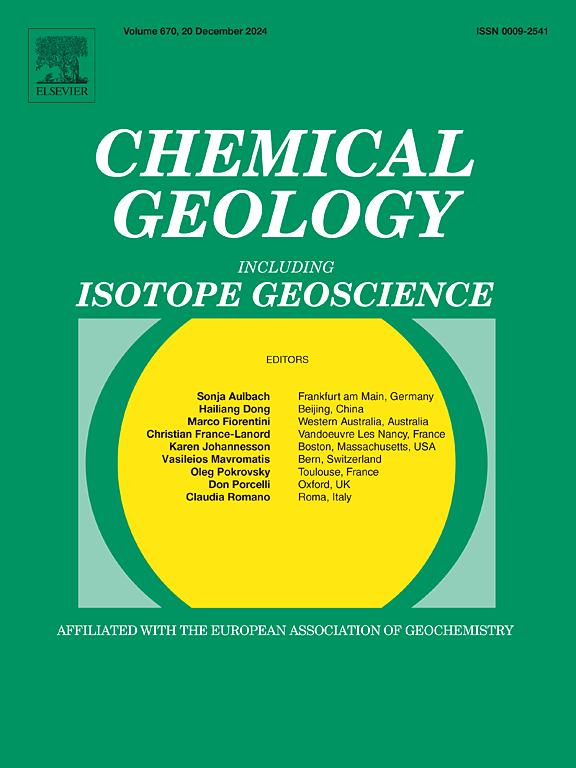Phosphate oxygen isotope insights into the coupled distribution of phosphorus, iron, and manganese in lake sediments
IF 3.6
2区 地球科学
Q1 GEOCHEMISTRY & GEOPHYSICS
引用次数: 0
Abstract
Understanding phosphorus (P) dynamics in lake and marine sediments is critical for predicting P re-release into water bodies and its stable accumulation through burial. The distribution of P in sediments is influenced by inputs from rivers and groundwater, as well as post-depositional redistribution processes, such as sink switching and geochemical focusing. Although P, iron (Fe), and manganese (Mn) dynamics are expected to be coupled under reductive conditions, the effects of terrestrial inputs and these redistribution processes on their behavior remain unclear. To assess P, Fe and Mn transport and accumulation in lake sediments, this study applied phosphate oxygen isotope (δ18OPO4) analysis to track P sources and redistribution, along with sequential extractions of sedimentary P, Fe, and Mn. The study was conducted in Lake Biwa, Japan's largest lake. We collected the samples of potential P sources (groundwater and river water) and sediments from nearshore to offshore areas. The δ18OPO4 values of Fe-bound P and concentrations of Fe-bound P, and reactive Fe and Mn in the sediments increased from nearshore to offshore. Such spatial trends can be explained by groundwater discharge with a high δ18OPO4 value and/or geochemical focusing with biological recycling (P uptake and release by organisms). Sedimentary P, Fe, and Mn concentrations were significantly correlated to organic matter concentrations in the sediments, suggesting that organic matter is crucial in their coupled dynamics. This study highlights the utility of δ18OPO4 for evaluating P sources and redistribution processes and the importance of the factors contributing to spatial heterogeneity for understanding lake biogeochemistry.
湖泊沉积物中磷、铁、锰耦合分布的磷氧同位素研究
了解湖泊和海洋沉积物中磷的动态变化对预测水体中磷的再释放及其通过埋藏的稳定积累至关重要。沉积物中磷的分布受河流和地下水输入以及沉积后再分配过程(如汇转换和地球化学聚焦)的影响。虽然在还原条件下,P、铁(Fe)和锰(Mn)的动力学预计是耦合的,但陆地输入和这些再分配过程对它们行为的影响尚不清楚。为了评估湖泊沉积物中P、Fe和Mn的运输和积累,本研究应用磷酸氧同位素(δ18OPO4)分析跟踪P的来源和再分配,以及沉积物中P、Fe和Mn的顺序提取。这项研究是在日本最大的湖泊琵琶湖进行的。我们收集了从近岸到近海的潜在磷源(地下水和河水)和沉积物样本。沉积物中Fe- binding P的δ18OPO4值以及Fe- binding P、活性Fe和Mn的浓度从近岸到近海呈增加趋势。这种空间趋势可以通过具有高δ18OPO4值的地下水排放和/或具有生物循环(生物吸收和释放P)的地球化学聚焦来解释。沉积物中P、Fe和Mn浓度与沉积物中有机质浓度呈显著相关,表明有机质在其耦合动力学中起着至关重要的作用。该研究强调了δ18OPO4在评估磷来源和再分配过程中的作用,以及对湖泊生物地球化学的空间异质性的影响因素的重要性。
本文章由计算机程序翻译,如有差异,请以英文原文为准。
求助全文
约1分钟内获得全文
求助全文
来源期刊

Chemical Geology
地学-地球化学与地球物理
CiteScore
7.20
自引率
10.30%
发文量
374
审稿时长
3.6 months
期刊介绍:
Chemical Geology is an international journal that publishes original research papers on isotopic and elemental geochemistry, geochronology and cosmochemistry.
The Journal focuses on chemical processes in igneous, metamorphic, and sedimentary petrology, low- and high-temperature aqueous solutions, biogeochemistry, the environment and cosmochemistry.
Papers that are field, experimentally, or computationally based are appropriate if they are of broad international interest. The Journal generally does not publish papers that are primarily of regional or local interest, or which are primarily focused on remediation and applied geochemistry.
The Journal also welcomes innovative papers dealing with significant analytical advances that are of wide interest in the community and extend significantly beyond the scope of what would be included in the methods section of a standard research paper.
 求助内容:
求助内容: 应助结果提醒方式:
应助结果提醒方式:


